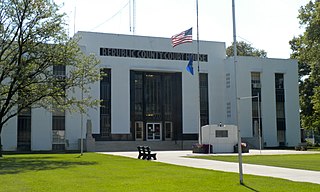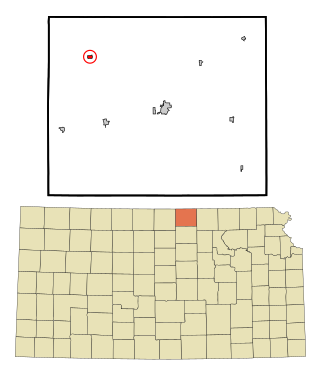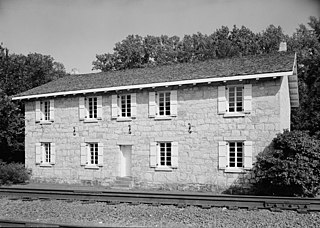
The Pawnee are a Central Plains Indian tribe that historically lived in Nebraska and northern Kansas but today are based in Oklahoma. They are the federally recognized Pawnee Nation of Oklahoma, who are headquartered in Pawnee, Oklahoma. Their Pawnee language belongs to the Caddoan language family, and their name for themselves is Chatiks si chatiks or "Men of Men".

Effigy Mounds National Monument preserves more than 200 prehistoric mounds built by pre-Columbian Mound Builder cultures, mostly in the first millennium CE, during the later part of the Woodland period of pre-Columbian North America. Numerous effigy mounds are shaped like animals, including bears and birds.

Pawnee County is a county in the U.S. state of Nebraska. As of the 2020 United States Census, the population was 2,544. Its county seat is Pawnee City.

Republic County is a county located in the state of Kansas, south from the Nebraska state line. Its county seat and largest city is Belleville. As of the 2020 census, the county population was 4,674. The county was named after the Republican River.

Republic is a city in Republic County, Kansas, United States. As of the 2020 census, the population of the city was 82.

Central City is a city and the county seat of Merrick County, Nebraska, United States. It is part of the Grand Island, Nebraska Metropolitan Statistical Area. The population was 2,934 at the 2010 census.

The Republican River is a river in the central Great Plains of North America, rising in the High Plains of eastern Colorado and flowing east 453 miles (729 km) through the U.S. states of Nebraska and Kansas.

The Native Sons of the Golden West (NSGW) is a fraternal service organization founded in the U.S. state of California in 1875, dedicated to historic preservation and documentation of the state's historic structures and places, the placement of historic plaques, and other charitable functions in California. In 1890 the organization placed California's first marker honoring the discovery of gold, which gave rise to the state nickname, "The Golden State". U.S. President Richard M. Nixon and Chief Justice Earl Warren served terms as presidents of the NSGW.

Waconda Spring, or Great Spirit Spring, was a natural artesian spring located in Mitchell County, near the communities of Glen Elder and Cawker City in the U.S. state of Kansas. It was a sacred site for Native American tribes of the Great Plains and, for a time, became the site of a health spa for American settlers. With the completion of the Glen Elder Dam in 1968, the mineral spring was sealed then disappeared beneath the waters of Waconda Reservoir.
The timeline of Kansas details past events that happened in what is present day Kansas. Located on the eastern edge of the Great Plains, the U.S. state of Kansas was the home of sedentary agrarian and hunter-gatherer Native American societies, many of whom hunted American bison. The region first appears in western history in the 16th century at the time of the Spanish conquest of the Aztec Empire, when Spanish conquistadors explored the unknown land now known as Kansas. It was later explored by French fur trappers who traded with the Native Americans. It became part of the United States in the Louisiana Purchase of 1803. In the 19th century, the first American explorers designated the area as the "Great American Desert."

The Pike-Pawnee Village Site, or Hill Farm Site, designated 25WT1 by archaeologists, is a site near the village of Guide Rock in Webster County, in the south central portion of the state of Nebraska, in the Great Plains region of the United States. It was the location of a village of the Kitkehahki band of the Pawnee people, in a region of the Republican River valley that they occupied intermittently from the 1770s to the 1820s.

The Kansas Historical Society is the official state historical society of Kansas.

The Pawnee Indian Museum State Historic Site, designated by the Smithsonian trinomial 14RP1, is an archaeological site and museum located near the city of Republic in the state of Kansas in the Midwestern United States. It is listed in the National Register of Historic Places under the name Pawnee Indian Village Site.

The First Territorial Capitol of Kansas is the sole remaining building of the ghost town of Pawnee, Kansas. The city served as the capital of the Kansas Territory for five days before it was moved to present day Lecompton, Kansas, and the town became part of neighboring Fort Riley. The building was the meeting place for the first elected Territorial Legislature in 1855. After falling into disrepair, the structure was restored in 1928 and today it serves as a history museum operated by the Kansas Historical Society and supported through The Partners of the First Territorial Capitol.

The Massacre Canyon battle took place in Nebraska on August 5, 1873, near the Republican River. It was one of the last hostilities between the Pawnee and the Sioux and the last battle/massacre between Great Plains Indians in North America. The massacre occurred when a large Sioux war party of over 1,500 Oglala, Brulé, and Sihasapa warriors, led by Two Strike, Little Wound, and Spotted Tail attacked a band of Pawnee during their summer buffalo hunt. In the ensuing rout, many Pawnees were killed with estimates of casualties ranging widely from around 50 to over 150. The victims, who were mostly women and children, suffered mutilation and sexual assault.

Guide Rock, whose Pawnee name is Pa-hur or Pahur, is a hill in south central Nebraska in the United States. In the traditional Pawnee religion, it was one of five dwelling places of spirit animals with miraculous powers.

Pahuk, also written Pahaku, or Pahuk Hill, is a bluff on the Platte River in eastern Nebraska in the United States. In the traditional Pawnee religion, it was one of five dwellings of spirit animals with miraculous powers. The Pawnee occupied three villages near Pahuk in the decade prior to their removal to the Pawnee Reservation on the Loup River in 1859.
Asa Thomas Hill was an American businessman and archaeologist. His work on sites in and around Nebraska, with such collaborators as William Duncan Strong and Waldo Wedel, was instrumental in the development of Great Plains archaeology.
The Dismal River culture refers to a set of cultural attributes first seen in the Dismal River area of Nebraska in the 1930s by archaeologists William Duncan Strong, Waldo Rudolph Wedel and A. T. Hill. Also known as Dismal River aspect and Dismal River complex, dated between 1650 and 1750 A.D., is different from other prehistoric Central Plains and Woodland traditions of the western Plains. The Dismal River people are believed to have spoken an Athabascan language and to have been part of the people later known to Europeans as the Apache.
















